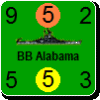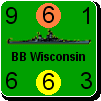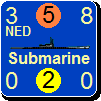Jagdtiger14
Posts: 1686
Joined: 1/22/2008
From: Miami Beach
Status: offline

|
quote:
4. I have always found limited overseas supply helps to make the Pacific war a bit more active. Without it, it always seems to fall back to a waiting game, with both sides keeping their main fleets in port until the other makes a move. I've never used this rule and not sure what to do. But, if you or someone else can fill me in on how this rule changes play and what I need to do to make sure I keep my troops in supply then sure, why not.
I've only played with this a couple times as it became too tedious for a board game. However, by computer, this might not be a bad option to play with. In our games the Japanese and US sailed out their CA's into various forward sea zones, in fact almost all sea zones had a CA's in the 4 or 3 box. The Japanese CA's are superior, but the main reason is to slow down the enemy. Its actually quite fun.
I disagree that the Pacific falls back to a waiting game...I have never seen a game like that (other than the US waiting for the Essex CV's). The Japanese need to use their fleet as much as possible and aggressively before the Essex class CV's show up (Fall '42)...the US waits for the Essex class, then makes their march across the Pacific. The Japanese fleet becomes a fleet in being, and only committed to critical events...normally protecting the Tokyo Express. If the Japanese aggressively built out their CV's (all of them including the CVL's), then there is a 1 year (or less depending on if the US advance built their 2nd round of Essex CV's) window before the second year Essex come on line where there could be many opportunities for huge carrier battles
< Message edited by Jagdtiger14 -- 6/30/2016 5:43:04 AM >
_____________________________
Conflict with the unexpected: two qualities are indispensable; first, an intellect which, even in the midst of this obscurity, is not without some traces of inner light which lead to the truth; second, the courage to follow this faint light. KvC
|
 Printable Version
Printable Version































 New Messages
New Messages No New Messages
No New Messages Hot Topic w/ New Messages
Hot Topic w/ New Messages Hot Topic w/o New Messages
Hot Topic w/o New Messages Locked w/ New Messages
Locked w/ New Messages Locked w/o New Messages
Locked w/o New Messages Post New Thread
Post New Thread